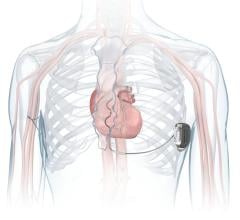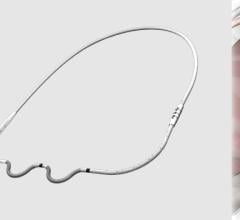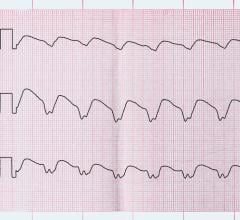May 9, 2016 — Medtronic announced the results of several studies evaluating a novel approach to implantable cardioverter defibrillator (ICD) therapy at Heart Rhythm 2016, the Heart Rhythm Society (HRS) annual meeting.
The Medtronic EV-ICD system, which currently is in development and not available for use or sale, is a new approach to ICD therapy with leads placed outside the heart and veins, and under the rib cage. The studies presented at HRS are the first to evaluate the new concept, and the results demonstrate that extravascular lead placement may provide the same benefits achieved with conventional ICDs, including pacing the heart in patients at risk of dangerous heart rhythms.
“While conventional ICDs are highly effective in providing life-saving therapy for patients at risk of sudden cardiac death, clinicians also are looking for an extravascular solution that provides similar benefits as transvenous ICDs, including pacing to terminate life- threatening heart rhythms,” said Joseph Chan, M.D., Prince of Wales Hospital, Hong Kong, who led one of the studies presented at Heart Rhythm. “The feasibility results presented are encouraging and show that the EV-ICD approach may be the solution physicians are seeking.”
The investigational Medtronic EV-ICD system consists of an implanted device, a newly designed lead, and procedure tools to guide the efficient delivery of the system. Like conventional ICDs, the system is designed to deliver life-saving electrical shocks to protect patients from sudden cardiac death, to deliver anti-tachycardia pacing (ATP) to pace the heart out of potentially life-threatening heart rhythms that can lead to sudden cardiac death, and to provide post-shock pacing. Like transvenous ICD systems, the Medtronic EV-ICD is projected to have longevity of approximately 10 years and an expected device volume of approximately 33 cc. In addition to these potential benefits, the EV-ICD approach is designed to prevent the rare, but potentially serious, risks that can occur when leads are implanted inside the vasculature and the heart.
In an oral abstract session, Chan presented the results from a prospective, non- randomized study of 16 patients scheduled to undergo a midline sternotomy or implant of an ICD, who were enrolled at five sites in Europe and Hong Kong. Using an introducer to guide the delivery of the defibrillation lead under the rib cage, the study determined that defibrillation is possible in this location with defibrillation results consistent with conventional ICDs.
In a second oral abstract session, Darius Sholevar, M.D., presented the results from a prospective, multicenter trial that assessed the feasibility of cardiac pacing from a lead placed outside the heart and under the rib cage (also referred to as extravascular, or substernal space). Substernal Pacing Acute Clinical Evaluation (SPACE) studied 26 patients from eight sites in the United States and Canada, and preliminary data demonstrated that pacing is possible from this extravascular space, with the majority of patients achieving consistent and appropriate ventricular pacing results.
These clinical data were further supported by other pre-clinical abstracts presented during Heart Rhythm, which assessed the feasibility of pacing and defibrillation with leads outside the heart and under the rib cage:
· Researchers developed a model to compare the amount of energy required for effective defibrillation in conventional ICDs, subcutaneous ICDs, and the investigational EV-ICD approach. The model showed that lead placement under the rib cage requires slightly more energy, on average, for defibrillation compared to conventional ICDs, and about half as much, on average, as current subcutaneous ICDs. These data were further supported by a second abstract demonstrating that the EV-ICD approach requires lower energy (defibrillation thresholds) than subcutaneous devices and comparable energy to conventional ICDs.
· A final abstract reinforced that pacing can be achieved with the lead placed in this extravascular space.
“The EV-ICD may be transformational for ICD therapy, with advancements for both patients and physicians,” said John Liddicoat, M.D., senior vice president, Medtronic, and president of the cardiac rhythm and heart failure division. “These feasibility study results are promising and have brought us one step closer to making this approach a reality for patients around the world at risk of sudden cardiac death.”
Sudden cardiac arrest is an abrupt loss of heart function that can result in death if not treated within minutes. Conventional ICDs involve leads (thin wires) connected to the heart to deliver shocks or ATP that restore normal heart rhythms. ICDs are proven to be 98 percent effective in treating dangerous ventricular arrhythmias that can lead to sudden cardiac arrest.[1,2]
In collaboration with leading clinicians, researchers and scientists worldwide, Medtronic offers the broadest range of innovative medical technology for the interventional and surgical treatment of cardiovascular disease and cardiac arrhythmias. The company strives to offer products and services that deliver clinical and economic value to healthcare consumers and providers around the world.
For more information: www.medtronic.com
References:
1. Zipes, DP, Roberts, D. for the Pacemaker-Cardioverter-Defibrillator investigators. Results of the International Study of the Implantable Pacemaker Cardioverter-Defibrillator: A Comparison of Epicardial and Endocardial Lead Systems. Circulation. 1995;92:59- 65.
2. Volosin et al. “Virtual ICD: A Model to Evaluate Shock Reduction Strategies.” Heart Rhythm. Vol. 7, N. 5, May supplement 2010. (PO3-125).


 February 12, 2024
February 12, 2024 








